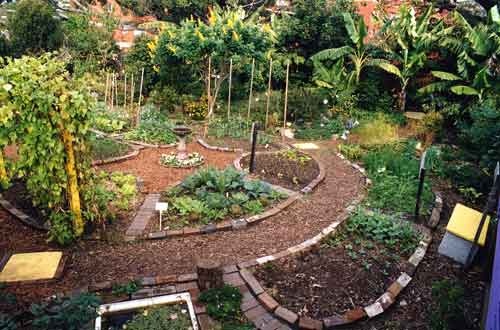Organic
gardening avoids the use of chemicals to make plants grow or protect them from
insects, relying instead on natural gardening principles used for thousands of
years. Permaculture organic gardening goes a step further and also emphasizes
growing plants sustainably, working with rather than against the grain of the
natural environment. Permaculture organic gardening is growing in popularity as
more people realize that it offers an inexpensive and relatively low-maintenance
way to grow their own fruits, vegetables, herbs and flowers.
(Our Note. . . . . . . If your like me you want to know exactly what a "Premacuture Garden" is so here's the best definition I could find, "Permaculture is about designing human habitats that have the stability, diversity and resilience of natural ecosystems. Permaculture integrates renewable energy systems, energy efficiency, food/gardening systems, natural building, rainwater harvesting, urban planning along with the economic, political and social policies that make sustainable living possible and practical.")
Observe your property at different times of day. Consider which areas receive the most sun, which are in shade for much of the day. Depending on where you live, if sunshine is a scarce commodity, you will want to expose plants to receive as much as possible. On the other hand, in desert regions, you will not want your plants to be in the area most likely to be parched by sun exposure. Also think protecting your garden from the paths where strong winds tend to blow through your property. Even a small property will have microclimates -- notice these and plant accordingly to give different plants either more sun or more shade according to their preference.
Read more extensively about the following at Natural News
Making a home for your plants
Feeding your plants
Watering your plants
Sources for this article include:
http://www.safecom.org.au/permaculture.htm
http://www.organicgardening.com
http://www.appropedia.org/Beginners_permaculture_garden
(Our Note. . . . . . . If your like me you want to know exactly what a "Premacuture Garden" is so here's the best definition I could find, "Permaculture is about designing human habitats that have the stability, diversity and resilience of natural ecosystems. Permaculture integrates renewable energy systems, energy efficiency, food/gardening systems, natural building, rainwater harvesting, urban planning along with the economic, political and social policies that make sustainable living possible and practical.")
Choosing
a location
Observe your property at different times of day. Consider which areas receive the most sun, which are in shade for much of the day. Depending on where you live, if sunshine is a scarce commodity, you will want to expose plants to receive as much as possible. On the other hand, in desert regions, you will not want your plants to be in the area most likely to be parched by sun exposure. Also think protecting your garden from the paths where strong winds tend to blow through your property. Even a small property will have microclimates -- notice these and plant accordingly to give different plants either more sun or more shade according to their preference.
Selecting plants test
Avoid disease-prone plants which require time-consuming chores such as spraying and pruning by the gardener. Select plants which will thrive in your area rather than those which will require extra labor on your part to protect them from the environment. As far as possible, select plants which serve multiple purposes, such as fruit trees which will put forth blossoms in one season, fruit to pick in another, and provide shade for when you want to sit and enjoy your garden's natural beauty. Native plants are also more likely to attract local pollinators such as bees, and to draw butterflies so that your garden contains even more natural beauty.Read more extensively about the following at Natural News
Making a home for your plants
Feeding your plants
Watering your plants
Sources for this article include:
http://www.safecom.org.au/permaculture.htm
http://www.organicgardening.com
http://www.appropedia.org/Beginners_permaculture_garden

No comments:
Post a Comment